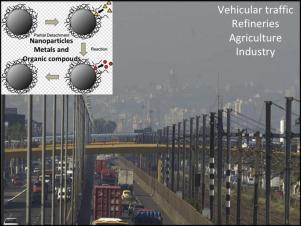Geoscience Frontiers ( IF 8.5 ) Pub Date : 2020-12-30 , DOI: 10.1016/j.gsf.2020.12.011 Ismael L. Schneider , Elba C. Teixeira , Guilherme L. Dotto , Diana Pinto , Cheng-Xue Yang , Luis F.O. Silva

|
Air pollution has become a major problem in urban areas due to increasing industrialization and urbanization. In this study ambient concentrations of PM1 and metal concentrations as well as source contributions were identified and quantified by using Positive Matrix Factorization (PMF) in receptor modeling in the Metropolitan Area of Porto Alegre, Brazil. The PM1 samples were collected on PTFE filters from December 2012 to December 2014 in two sampling sites. Major ion and trace element concentrations were assessed. The average concentrations were 12.8 and 15.2 μg/m3 for Canoas and Sapucaia do Sul sites, respectively. Major ion contributions of PM1 were secondary pollutants such as sulfate and nitrate. Trace elements, especially Cu, Pb, Zn, Cd, and Ni also made important contributions which are directly associated with anthropogenic contributions. Our results show significantly higher levels in winter than in summer. Most of the PM1 and the analyzed PM species and elements originated from anthropogenic sources, especially road traffic, combustion processes and industrial activities, which are grouped in 7 major contributing sources. A back-trajectory analysis showed that the long-range transport of pollutants was not relevant in relation to the contribution to PM1 and metal concentrations. This work highlights the importance of urban planning to reduce human health exposure to traffic and industrial emissions, combined with awareness-raising actions for citizens concerning the impact of indoor sources.
中文翻译:

大都市区亚微米颗粒物(PM1)地球化学研究
随着工业化和城市化进程的加快,空气污染已成为城市地区的主要问题。在这项研究中,通过在巴西阿雷格里港大都市区的受体建模中使用正矩阵分解 (PMF) 来识别和量化PM 1 的环境浓度和金属浓度以及源贡献。从 2012 年 12 月到 2014 年 12 月,在两个采样点使用 PTFE 过滤器收集了PM 1样本。评估了主要离子和微量元素的浓度。Canoas 和 Sapucaia do Sul 站点的平均浓度分别为 12.8 和 15.2 μg/m 3。PM 1 的主要离子贡献次生污染物如硫酸盐和硝酸盐。微量元素,特别是 Cu、Pb、Zn、Cd 和 Ni 也做出了重要贡献,它们与人为贡献直接相关。我们的结果表明,冬季的水平明显高于夏季。大多数 PM 1和分析的 PM 种类和元素来自人为来源,特别是道路交通、燃烧过程和工业活动,它们分为 7 个主要贡献源。回溯分析表明,污染物的长距离传输与 PM 1的贡献无关和金属浓度。这项工作强调了城市规划对于减少人类健康暴露于交通和工业排放的重要性,并结合提高公民对室内源影响的认识行动。











































 京公网安备 11010802027423号
京公网安备 11010802027423号